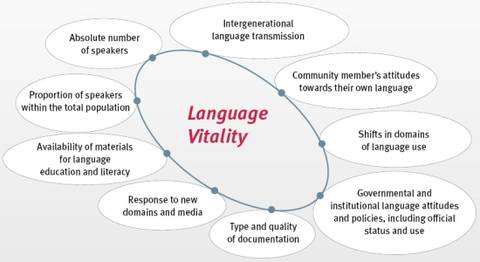I speak my favourite language because That’s who I am. We teach our children our favourite language, because We want them to know who they are.
United Nations dedicates every year to raise awareness on a topic of global interest and mobilises coordinated action around the world. This year, 2019, is dedicated as International Year of Indigenous Languages. In 2016, The United Nations General Assembly adopted a resolution (A/RES/17/178) proclaiming 2019 as International Year of Indigenous Languages, based on a recommendation made by the Permanent Forum on Indigenous issues. In 2016 the Planning Forum expressed concern 40% of the world’s estimated 6,700 languages were in danger of disappearing – the majority of them belonging to indigenous people.
The International Year of Indigenous Languages (IYIL) aims to act in five areas:
- Increasing understanding, reconciliation and international cooperation.
- Creating favourable conditions for knowledge-sharing and dissemination of good practices.
- Integrating indigenous languages into a standard-setting.
- Empowering through capacity building.
- Elaborating new knowledge to foster growth and development.
Developments in India
In 2013, the Ministry of Human Resource Development, government of India, instituted the Scheme for Protection and Preservation of Endangered Languages (SPPEL). The primary objective of this Scheme is to document and archive the country’s languages that have become endangered or likely to be endangered in the near future. This particular scheme is monitored by the Central Institute of Indian Languages (CIIL), Mysore. CIIL has collaborated with many Indian Universities for this mission.
At present, the languages which are spoken by less than 10, 000 speakers or languages which are not studied linguistically earlier are documented by this Government of India Scheme. The record states that 117 languages have been listed for the documentation. Documentation in the form of grammar, dictionary and ethnolinguistic profiles of about 500 lesser-known languages are estimated to be documented in the coming years.
ZONE WISE Endangered Languages
Northern Zone: The languages spoken in Chandigarh, Haryana, Himachal Pradesh, Jammu & Kashmir, Punjab, Uttar Pradesh, and Uttarakhand are documented by this scheme.

Zone wise endangered languages list. Source: sppel.org
NorthEast Zone: There are 8 states in this zone, namely, Arunachal Pradesh, Assam, Manipur, Meghalaya, Mizoram, Nagaland, Sikkim, and Tripura. The languages that are spoken by the indigenous people in this area are documented by this scheme (SPPEL).
East Central Zone: Depending upon the geographical distributions of the languages, SPPEL has recognised 6 zones. One of them is East Central Zone and SPPEL has chosen 9 languages to work upon.
West Central Zone: This zone is attached to the states/union territories of Gujarat, Maharashtra, Rajasthan, Daman & Diu, Nagar Haveli, and Goa.
Southern Zone: SPPEL has identified 6 zones based on the geographical distribution of languages. 18 languages have been chosen by SPPEL to work upon.
The motto of SPPEL, MHRD, Government of India is to see that the endangered languages are protected and preserved for their survival.
Another study shows that there are 7000 languages spoken in the world and approximately 2600 are endangered. Critically endangered languages are those whose youngest speakers are either grandparents or older.
Causes for language extinction
The world serves as a home to an extraordinary level of linguistic diversity with 7000 languages spoken and signed. Yet this is highly unstable and is being rapidly eroded through a series of complex processes that lead to language loss. Combination of monolingualism and networks of global trade languages which are increasingly technologized have led to the world population speaking only 13 languages. Such linguistic homogenization leads to language loss.
Natural disasters, though unique to particular language communities and specific geographical regions may have been reasons for the endangering of languages across the globe. The harmful legacy of colonization and the enduring impact of disenfranchising policies related to indigenous and minority languages are at the heart of language attrition from New Zealand to Hawaii and from Canada to Nepal.
Measuring Language Endangerment, Revitalisation and Language Loss
A highly regarded and widely used method for gauging the status and prospects of a language is the UNESCO Language Vitality Assessment (Brenzinger et al., 2003). This tool advances a holistic approach for measuring linguistic vitality that draws on multiple elements as no single factor could be used to assess a language’s vitality or its need for documentation (Brenzinger et. al., 2003; p. 7)
In 2002 and 2003, UNESCO asked the International group of linguists to develop a framework to determine the vitality of a language in order to assist in policy development, identification of needs and appropriate safeguarding measures. This Ad Hoc Expert Group on Endangered Languages elaborated a paper entitled, “Language Vitality and Endangerment“, which established the below mentioned nine criteria.

Language vitality and Endangerment (UNESCO)
These nine factors can determine the viability of a language, its function in society, and the type of measures required for its maintenance or revitalisation.
Language Vitality Assessment: An Example from Venezuela – A Case Study
Nine factors have been proposed to assess language vitality and the need for documentation. These nine factors could be applied simultaneously to several languages in order to get a comparative picture of their relative strength, appraise their contrasting sociolinguistic situation, and to establish priorities for action. The following example illustrates the comparative application of the factors across three indigenous languages of Venezuela, a country that recognizes and protects its minority languages. Mapoyo is a Cariban language which is spoken no longer but remembered by few elders in a multi-ethnic community. All of these members speak Spanish which is the first language learnt by Mapoyo children. Karì ña is also a Cariban language but has many speakers and most of them are bilingual. Some elders learnt Karì ña as their first language and they could speak it fluently. Nowadays Spanish is the preferred language for Karì ña speakers, numbering over 8000 approximately. Sanima related to Yanomami has approximately 2000 speakers, yet few of them are bilingual.
Conclusions
The World faces new challenges in keeping languages alive and well. It is time for the people to pool their resources at all levels: individual language specialists, local community, NGOs and Governmental and Institutional Organisations and build on the strengths of linguistic and cultural diversity.
If we don’t speak then there is no world.
The author acknowledges the use of authentic literature to write this article.
Sign up for the QuackTrack.org newsletter below!
















